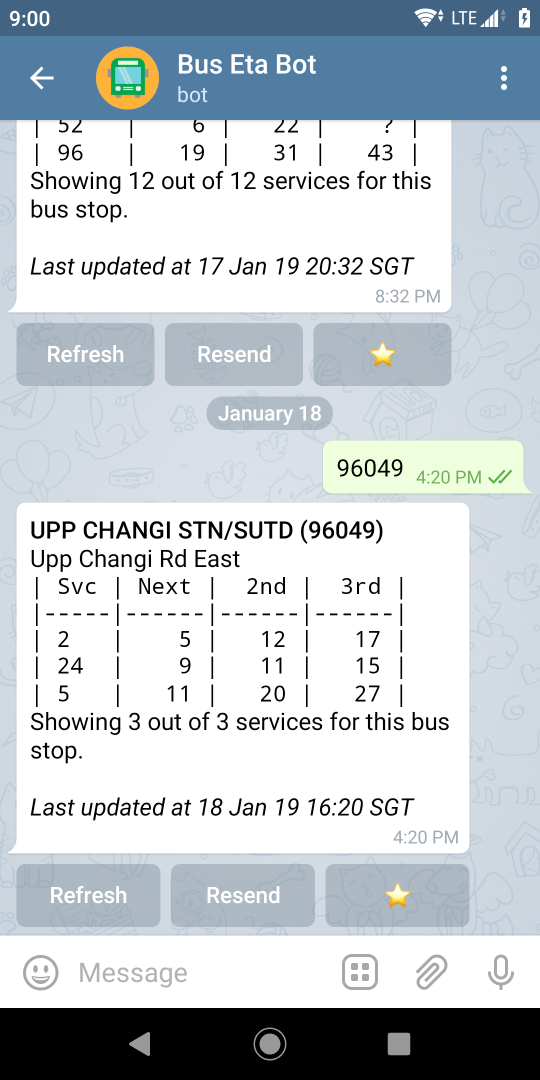Bus Eta Bot is a Telegram bot for getting bus arrival times from the LTA DataMall API.

It is written in Go and hosted on the App Engine standard environment for Go.
Stackdriver tracing on App Engine standard
In the App Engine standard environment, applications run in a sandboxed environment and are subject to various restrictions and vendor lock-in. However, in return you do get tracing for free with Stackdriver Trace. For example, here's a trace of a typical request handled by Bus Eta Bot:

Because Bus Eta Bot uses the App Engine specific appengine/urlfetch and appengine/datastore packages, outgoing HTTP requests and Cloud Datastore operations are automatically traced and can be viewed on the Cloud Console.
Notes on the App Engine Go 1.11 Standard Environment
In the App Engine Go 1.11 Standard Environment, the standard library net/http HTTP client and generic Google Cloud client libraries can be used instead of their App Engine-specific counterparts. While doing so eliminates some inconveniences such as having to create a new HTTP client per request, it also loses the automatic Stackdriver Trace instrumentation.
Adding custom traces to Stackdriver
Here's a trace which includes with a custom, non-App Engine span in the in the midst of all the others:

Here, I've added a trace for the InMemoryBusStopRepository.Nearby method in my code. This method finds bus stops within a certain distance of a certain location by looping through a list of bus stops in memory, and I wanted to compare its performance to another implementation which used the App Engine Search API.
Setting up OpenCensus
First, we need to set up a OpenCensus exporter for StackDriver, as documented in Setting up Stackdriver Trace for Go:
// import "contrib.go.opencensus.io/exporter/stackdriver"
// import "go.opencensus.io/trace"
// Create and register a OpenCensus Stackdriver Trace exporter.
exporter, err := stackdriver.NewExporter(stackdriver.Options{})
if err != nil {
log.Printf("error setting up opencensus stackdriver exporter: %+v\n", err)
} else {
trace.RegisterExporter(exporter)
trace.ApplyConfig(trace.Config{DefaultSampler: trace.AlwaysSample()})
}
The provided stackdriver.Options can be empty because there's no need to provide application credentials inside App Engine. Depending on the amount of traffic you're expecting, you can also configure OpenCensus to always sample traces to see results immediately (otherwise, not all traces will be recorded).
Getting the correct parent span
The StartSpan method in the go.opencensus.io/trace package will start a new child span if its context.Context argument already contains a span. However, because we're integrating with the existing non-OpenCensus instrumentation, we can't simply do this. Instead, we need to create a parent span based on the information contained in the X-Cloud-Trace-Context header passed to an App Engine request.
We can do this using the SpanContextFromRequest method on the HTTPFormat struct exported by the go.opencensus.io/exporter/stackdriver/propagation package:
// import "go.opencensus.io/exporter/stackdriver/propagation"
var HTTPFormat = propagation.HTTPFormat{}
parent, ok := HTTPFormat.SpanContextFromRequest(req)
Creating a new child span
If we manage to extract a parent span, we can create a new child span using trace.StartSpanWithRemoteParent and use it normally:
// import "go.opencensus.io/trace"
// import "go.opencensus.io/exporter/stackdriver/propagation"
var HTTPFormat = propagation.HTTPFormat{}
if parent, ok := HTTPFormat.SpanContextFromRequest(req); ok {
_, span := trace.StartSpanWithRemoteParent(ctx, "InMemoryBusStopRepository/Nearby", parent)
defer span.End()
}
You will be able to see your created spans together with the rest of the App Engine spans in Stackdriver Trace after the request is complete.
Wrapping up
The code samples above are intentionally brief to focus on the essential methods. In practice, the functions you want to trace may not be directly handling the incoming request from App Engine, so you will need a way to pass the parent trace.SpanContext to the function you actually want to create the child span in. One way to do this is by putting it on a unique key in a context.Context you pass down the call chain:
import (
"context"
"net/http"
"contrib.go.opencensus.io/exporter/stackdriver/propagation"
"go.opencensus.io/trace"
"google.golang.org/appengine"
)
var HTTPFormat = propagation.HTTPFormat{}
type parentSpanKey struct{}
// newContext creates a new context from an incoming App Engine request to be passed through the application.
func newContext(r *http.Request) (ctx context.Context) {
// create a new appengine context from the incoming request
ctx = appengine.NewContext(r)
if parent, ok := HTTPFormat.SpanContextFromRequest(r); ok {
ctx = context.WithValue(ctx, parentSpanKey{}, parent)
}
return
}
// parentSpanFromContext extracts a *trace.SpanContext from ctx.
func parentSpanFromContext(ctx context.Context) (*trace.SpanContext, bool) {
parent, ok := ctx.Value(parentSpanKey{}).(*trace.SpanContext)
return parent, ok
}
func doStuff() {}
func someTracedFunction(ctx context.Context) {
if parent, ok := parentSpanFromContext(ctx); ok {
_, span := trace.StartSpanWithRemoteParent(ctx, "someTracedFunction", parent)
defer span.End()
}
doStuff()
}